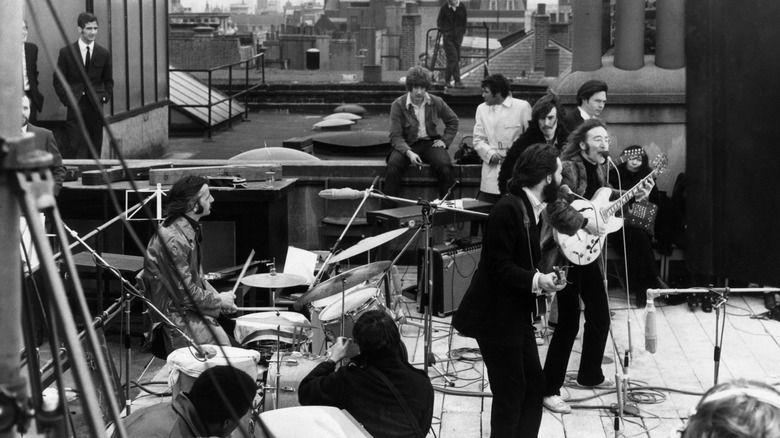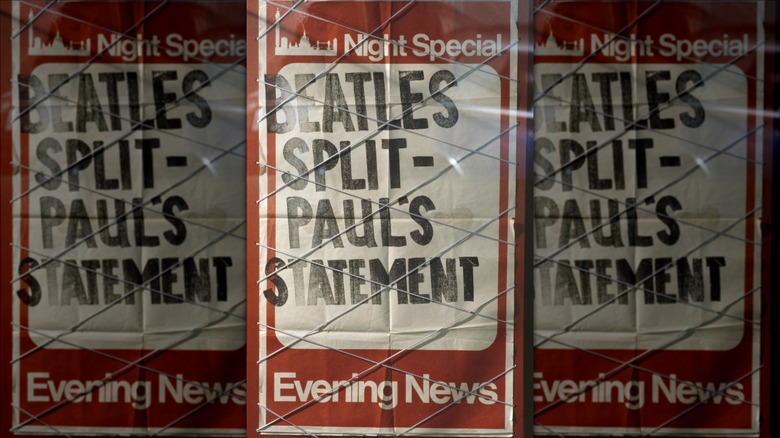Why The Beatles Documentary 'Let It Be' Disappeared For More Than 50 Years
On April 15, 2024, Walt Disney Studios published on their social media channels a cryptic image of four white squares. "At last ..." the caption read. Tantalizingly, below the squares was a familiar logo for the iconic 1960s band The Beatles. As excitement grew among fans as to what the announcement might be, many pointed to the fact that the image resembled the arrangement of the four portraits of band members John Lennon, Paul McCartney, George Harrison, and Ringo Starr on the cover of "Let It Be," the group's last album to be released before they split in 1970. Some then speculated that the streaming giant was about to announce the re-release of a very rare documentary filmed around the time of that album, also named "Let It Be," which first appeared in movie theaters after the band's much-publicized demise. And days later, fans were proved right, with Disney+ confirming that "Let It Be" would air on the platform on May 8, 2024.
Disney+ has enjoyed considerable success partnering with The Beatles in recent years. In 2021, they released to great fanfare "The Beatles: Get Back," a three-part docuseries made with remastered footage and audio collected during the filming of "Let It Be." "The Beatles: Get Back" represented a huge commercial success for Disney+, but the original "Let It Be," which was a critical and commercial failure upon its release, has been unavailable since its original release more than 50 years ago. Here's the story of the long-lost Beatles film, and why it has been missing for so long.
After years of creative success tensions were developing within the band
Today, the Beatles' discography is considered an almost perfect catalog of boundary-pushing pop genius. Recorded over the course of just seven years between 1963 and 1970, the singles and studio albums the Fab Four released remain touchstones for songwriters everywhere and a rite of passage for young music fans the world over. But while it is easy to look back on the music of The Beatles as a singular monolithic success, that wasn't quite how things went at the time, especially as the 1960s came to an end.
From the release of "Rubber Soul" in 1965, The Beatles' songwriting and production values became increasingly experimental and ambitious. Their 1967 LP "Sgt. Pepper's Lonely Hearts Club Band," a concept album based around a fictional alter ego, was considered a landmark in the history of recorded music, while their follow-up double LP "The Beatles," known as "The White Album," was yet another high-minded statement. But with the loss of the band's long-time manager, Brian Epstein, in August 1967, recording sessions were becoming increasingly strained. In response, Paul McCartney, who some fans see as having become the de facto leader of the group, envisaged the "Get Back" project, an attempt to get back to their early methods of writing and recording and rock influences.
But rather than simply an album, "Get Back" was to be a grand TV special, accompanied by a making-of documentary. But as the documentary shows, the project was abandoned, with both the album and documentary of "Let It Be" only being released after the band had already broken up.
The film was critically panned
The Beatles' final released album, "Let It Be," is today considered a flawed but vital piece of their discography. Containing their late hit singles "Get Back" and "Let It Be," the album has received both a popular remake, 2003's "Let It Be... Naked," and has been remastered and rereleased numerous times. However, to many fans and critics at the time, "Let It Be" represented the unappealing sound of a tired band on its last legs. A scathing review from the NME's Alan Smith described the album as a "cardboard tombstone" for the recently split band, per The Conversation, while others pointed to the overwrought production, the work of Phil Spector, which critics noted went against the back-to-basics ethos of the original project. Nevertheless, the album topped the charts on both sides of the Atlantic.
But worse criticism was to be received by the documentary. Directed by Michael Lindsay-Hogg, a young filmmaker who appears in "The Beatles: Get Back," the movie was universally panned by critics upon its release in 1970. The Guardian, for example, gave the album light praise but described Lindsay-Hogg's documentary as an abject failure that made for boring viewing even as it lifted the lid on the inner workings of the biggest band of their generation. Released in cinemas mainly for contractual reasons with little support from The Beatles themselves — none attended its premiere — "Let It Be" was a commercial flop.
'Let It Be' made for grim viewing for fans and the band
To fans at the time, the "Let It Be" documentary represented an unprecedented snapshot into the wounds that had opened between the individual members of The Beatles, and seemed to demonstrate that The Beatles' split in 1970 had been precipitated by years of bitter arguing and rancor, an impression that was only challenged decades later with the release of "The Beatles: Get Back." It made for grim viewing among fans, but was also reviled by The Beatles themselves.
"There are scenes in it like the rooftop concert that was good," said George Harrison, who in the film is shown arguing repeatedly with John Lennon and Paul McCartney (via "The Beatles Book," by Hunter Davies). "But most of it makes me so aggravated. I can't watch it because it was a particularly bad experience that we were having at that time and it's bad enough having it, let alone having it filmed and recorded so you've got to watch it for the rest of your life. I don't like it!" Paul McCartney and Ringo Starr have similarly described the pain they felt watching "Let It Be," while Rolling Stone's Jann Wenner claims that he witnessed John Lennon weeping as he watched the documentary in a movie theater.
Attempts at release have worsened the reputation of Let It Be
Despite marketing around the rerelease of the "Let It Be" film claiming it has been unseen for more than half a century, there have been several attempts to help the controversial documentary see the light of day. The first came in the early 1980s when it was released on VHS home video and was widely bootlegged. According to Michael Lindsay-Hogg, this "changed the original aspect ratio and had dark and gloomy pictures and bad sound. That is part of the reason the movie was put in the closet for a long time," per The New York Times. Another reason was The Beatles themselves, who, despite rumors of a remastering and rerelease of the film in 1991, 1997, 2003, 2011, and 2013, later released a statement stating that "Let It Be" would not be rereleased during the surviving members' lifetimes as it was at risk of damaging the band's image.
Now, however, it seems that the time for Michael Lindsay-Hogg's film has come, with the 1970 movie finally considered worthy of distribution in the wake of "The Beatles: Get Back." According to Lindsay-Hogg, "Get Back" director Peter Jackson, whose production company provided the technology to remaster the film, was instrumental in getting the surviving Beatles' approval to rerelease it. Lindsay-Hogg is convinced that in the context of "Get Back" fans coming to it for the first time will see its notoriety is unjustified. Jackson agrees, telling The Guardian: "It's only right that his original movie has the last word."


